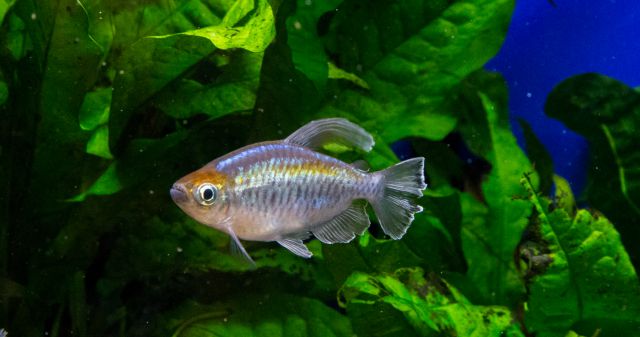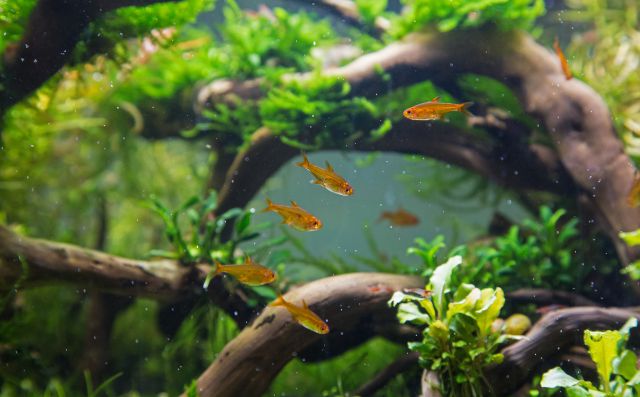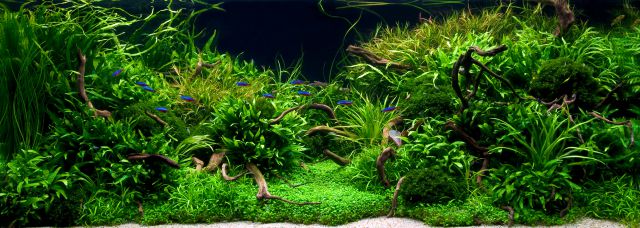Even if only a very small part of the tetra family is relevant for the aquarium, the natural variety with over 1900 known species is very high. Most imported ornamental fish are tetras, such as the classic neon fish. hatchet belly fish, penguin fish and even piranhas. Many animals of this family are peaceful schooling-fish, therefore, tetras should be kept in larger groups. They are easy to care for, and socialization with other fish species is possible.
The largest amount of tetras comes from South America, especially from the upper Amazon region. There, among other things, both black- and clearwater biotopes are populated. A smaller part of the species, however, is native to Africa - such as the popular congo tetra.

Characteristics
In terms of both coloration and body shape (narrow or high-backed), tetras are impressive because of their enormous diversity. In this respect, it is difficult to define characteristics typical of tetras. However, almost all tetras have the so-called adipose fin. Such is the name given to the small fin between the tail and dorsal fin of the fish. Most of the known tetra species remain rather small, so that they have become very attractive as a social animals for the aquarium.
Keeping
Tetras are social animals and show swarming behavior or they swim in loose formation, if a sufficient group size is met. The aquarium should therefore have a correspondingly large free swimming area. Additionally some hideouts and refuges in shape of aquatic plants and decoration like driftwood and stone structures need to be present, since some tetra species are territorial and need suitable structures for it. If they feel comfortable, they do not hide permanently and can be observed well in open water even under intense light.

Most tetra species feel the most comfortable in softer, acidic water. If the starting water is too hard and alkaline, more suitable water values can be produced by certain measures. We have described those in more detail in the article "Lowering the pH in the aquarium". The temperature for the keeping of these animals differs from species to species. The range of about 23 to 27 ° - as for most tropical ornamental fish - is common. If the room temperature is too low, the aquarium needs to be equipped with a heater.
Tetra are usually omnivores. Varied food and economical feeding improve the vitality of the animals. The menu can be supplemented with regular additions of frozen or live food. Here, however, attention should be paid to keep it bite-sized.

Overall, the keeping of tetras is quite simple, only the breeding is a bit more difficult. In doing so, special attention should be paid to the water parameters. The breeding aquarium is equipped with special spawning grids or wool as a spawning substrate. These aids prevent the parents from going for the eggs.
Suitable for a planted aquarium
Most common tetra species are well-suitable for a planted aquarium, because like many aquatic plants they prefer soft, acidic water. These fish are particularly suitable for aquariums equipped with soil substrate. The soil keeps the pH in an acidic range and hardness in a soft range for a while. In addition, most species of tetras do not go for the plants, as opposed to larger African cichlids. Above all, the splendor of colors and the great swarm behavior make tetras very attractive for a plant aquarium or aquascape.

With their colours, the fish form a beautiful contrast to the decoration and plants. An imposing, swimming school of fish comes into its own in a landscaped aquarium. Often a single group of tetras is used as the sole fish species in a plant aquarium, giving off a special aura of peace and harmony. Thus, there is no rush and unrest caused by too many different types of fish with different colors and shapes.
Can’t decide for a fish to keep in your aquarium? Then, we recommend you our article on "finding the right fish for your aquascape".